Does Bleach Kill Mold? Using This Common Cleaner May Be A Huge Risk
By: Licensed Mold Assessor Brad Fishbein
August 7, 2018
So you got a continuous black spot along a wall in your home.
It’s just a little mold…
…You can just put some bleach on it and it will go away, right?
RIGHT??!!
Some of what you read below may straight blow your mind!
Here’s the thing:
If you listen to government agencies until recently, the EPA (Environmental Protection Agency), and OSHA (Occupational Safety and Health Administration) both had in their guidelines to use Chlorine based bleach as part of their mold remediation process.
We were conditioned as kids to believe that if you have mold, you can just put some bleach on it, no big deal. It’s one of those things that may not be scientifically true, but an older family member used to say it to you. Kind of like an old folktale. Grandmas are always good for that.
Here’s some examples:
Sort of like when you would hear something like carrots will make your vision better at night or chocolate gives you acne, or maybe that gum takes 7 years to digest.
Anyways, you get what I’m saying…
Well, in recent years, government agencies have stopped recommending the use of bleach during the remediation process, but that doesn’t mean bleach is completely useless in combating mold.
As a matter of fact, Bleach has a place in the mold removal process (although there are better options), just not how you may think.
Does Bleach Kill Mold?
Bleach does not penetrate all surfaces to kill mold. Because of this, bleach should only be used to remove surface mold but only on non-porous items such as bathroom titles or plastic.
Even the Clorox company who manufactures bleach has a section on their website where they will tell you how to kill mold on walls and ceilings using bleach.
Now:
I don’t blame Clorox for stating you can dilute bleach and apply it to walls and ceilings to kill mold.
Afterall, they are a business and the more uses that you have for Clorox, the more you will buy it. But that doesn’t necessarily mean that this is accurate.
Here is what a section of their Q and A part of their website says:
Q. I have mold on my ceilings and walls. How do I dilute Clorox® Regular-Bleach to spray on it and kill it?
A. Clorox has several ways for you to do this. Clorox® Regular-Bleach1 can be made into an effective solution and applied directly to the problem area. Or, potentially more convenient would be our Tilex® Mold & Mildew Remover (which has the same sodium hypochlorite active ingredient as Clorox® Regular-Bleach1, and can be sprayed on the mold/mildew and then rinsed away after the appropriate contact time).
https://www.clorox.com/dr-laundry/getting-rid-of-moldmildew-on-walls/#2VSjVAvt036cRlzC.99
If you were to read that, you would think that:
” Hey, maybe I’ll use Bleach to kill that mold on my ceiling.”
But that my friend would not be a very good idea.
Surfaces You Can Use Bleach On To Treat Mold
The only time that bleach should be used to effectively treat microbial growth is surface mold on non-porous items.
Don’t worry:
If you don’t know the difference between porous and non-porous building materials, here’s a quick lesson for you.
Porous Building Materials
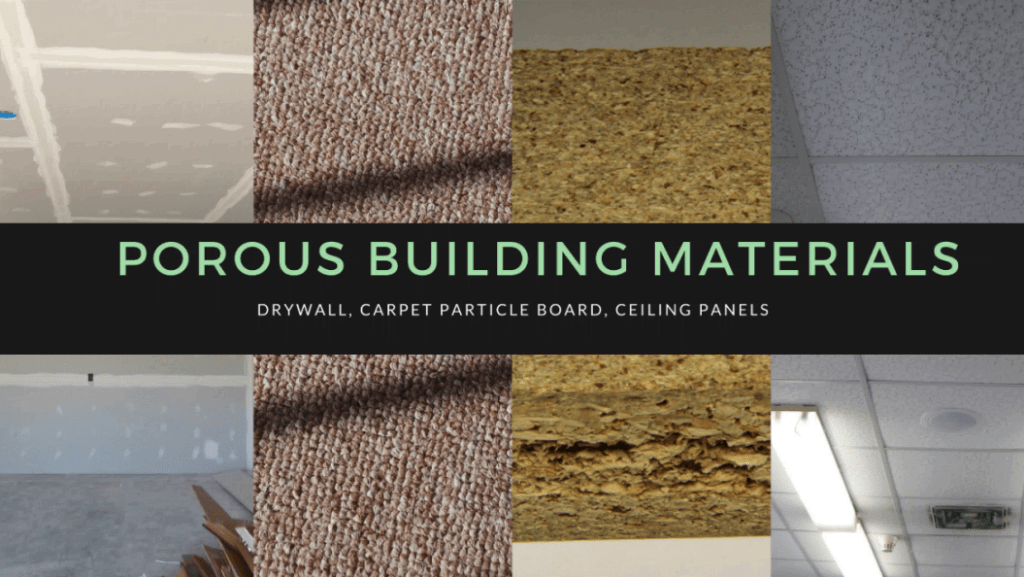
When building materials are referred to as porous it means that it contains any type of pores, voids or little holes where liquid or gas can pass through.
Porous building materials will absorb moisture and this allows mold to thrive on this type of building material.
Examples of porous building materials that are normally found in homes are:
- Drywall
- Ceiling Panels
- Particle Board
- Carpet
The one thing all four of these have in common is that they are cellulose based. One type of building material that is porous (or semi-porous depending upon how it is constructed) but mold has a hard time growing on it is plaster.
Plaster itself may be very porous but some of the components that are used to install it may turn it into non-porous such as certain types of glue.
Even if it is porous, mold will not generally grow on it.
The reason why:
It is lime based and not cellulose based.
Semi-Porous Building Materials
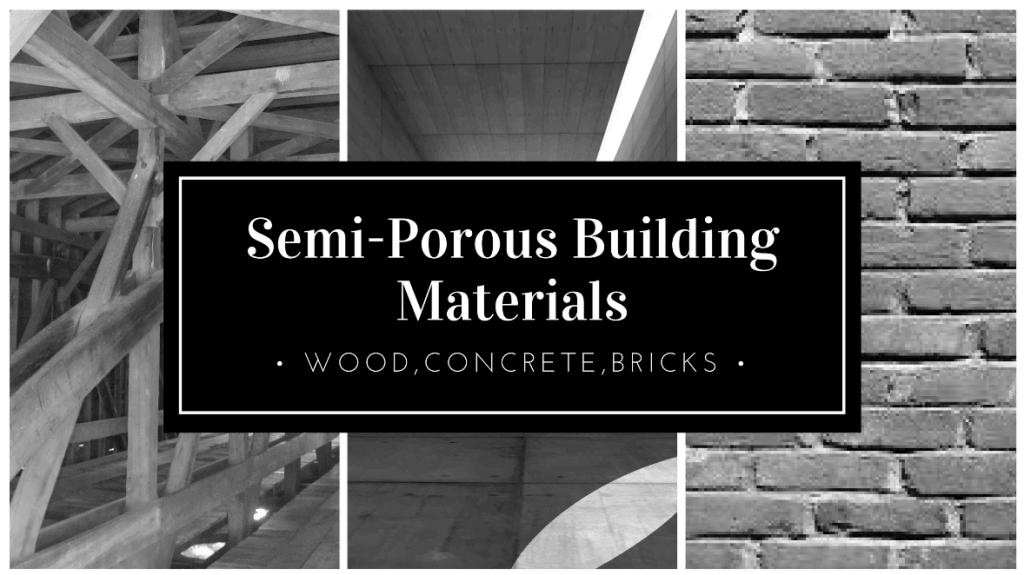
So obviously I don’t have to tell you that the word semi suggests that building materials with this label are not all the way porous.
But what exactly is the big difference?
You see:
Porous materials will absorb water really quickly. If you were to have a leak that was to damage drywall, it would get wet so quickly and densely that if you would apply just a moderate amount of pressure with your hand, it will go directly through the wall.
As a matter of fact, if an area of porous building material got wet enough and not dried out in a reasonable amount of time, it should be completely removed, but that is for another day.
That’s not the case with items that are semi-porous.
Semi-porous building materials do have pores and will absorb water. If the building material is organic, it can support mold growth.
However…
…It will do so at a much slower rate.
That is really the only difference between porous and non-porous building materials that may have gotten wet.
So what type of building materials are semi-porous?
Some examples are:
- Wood
- Concrete
- Bricks
- Oriented Strand Board
The good part about semi-porous building material is that they usually can be treated when mold starts to grow on them.
But:
Bleach may not be your best option to clean it with, more on that later.
Non-Porous Building Materials
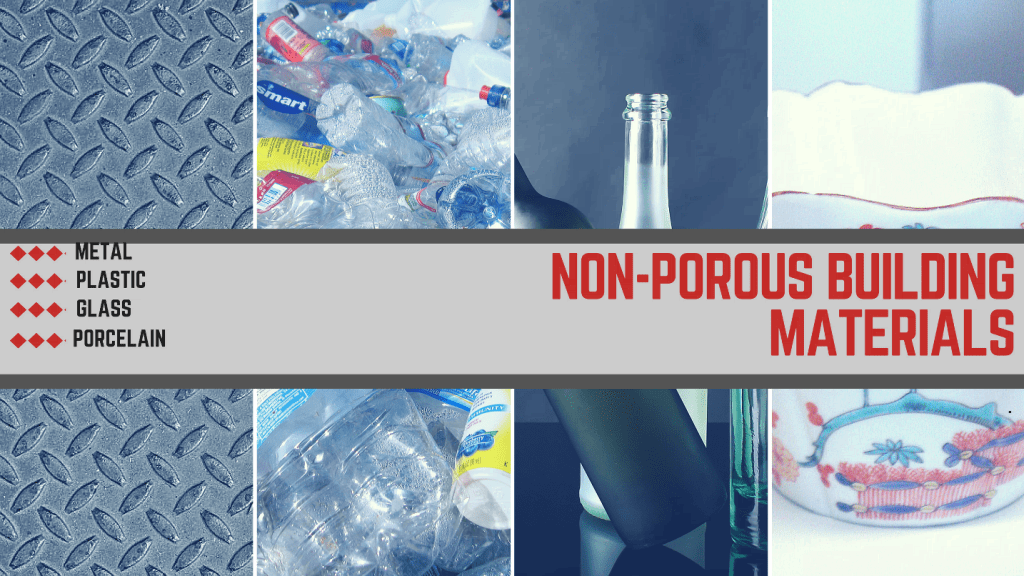
Non-porous means, well, I’m sure you guessed it by now…
Not porous!
Mold will not easily grow on these types of materials. It will land on it, it will hang out on it, but non-porous generally will not support mold growth.
Some Non-Porous building materials include:
- Metal
- Plastic
- Glass
- Porcelain
Ok:
Here is where our good friend bleach comes mighty handy. While science does not necessarily suggest that bleach will actually kill mold, many mold professionals and research suggests that non-porous and hard surfaces can be cleaned effectively with bleach. I guess they are just stuck in the old way of thinking. I recommend using other products which I will talk about in a little bit.
So if you would like to clean your kitchen countertops, toilets, showers, etc., with bleach, then, by all means, go ahead, it won’t hurt.
But…
Bleach should not be used to treat porous and non-porous surfaces during the mold remediation process.
Why Bleach Shouldn’t Be Used In The Mold Remediation Process
So let’s take away the fact that the EPA and OSHA no longer recommend that bleach should be used to remove mold.
Why else would it not be recommended that bleach is used to treat mold problems?
Well for one, bleach doesn’t kill mold.
Yes, it will remove the color out of mold and make the appearance of it disappear. Because of this, it gives off the illusion that bleach kills mold.
Scientific Proof
I don’t expect you to just take my word for it, so what I did was find you scientific proof that while bleach will remove the appearance of mold, it doesn’t necessarily kill the root cause of the mold. When bleach is used to treat it, the chance exists that the mold can grow back, especially if the area is still wet.
This was confirmed by a study conducted by the University of Oregon State. One of the purposes of the study was to examine if bleach can prevent or remove mold growth from Douglas-fir Lumber.
This is an excerpt from the end of the study:
While bleach is often recommended for remediation of surface mold on wood, our results illustrate that the treatment does not eliminate the surface microflora. As a result, an important component of remediation must be drying to moisture levels below 20 percent (the generally accepted level for inhibiting growth of fungi on wood) (Zabel and Morrell 1992). In the absence of drying, some fungi clearly survive the treatment and may re-colonize the surface
Proof In Your Home
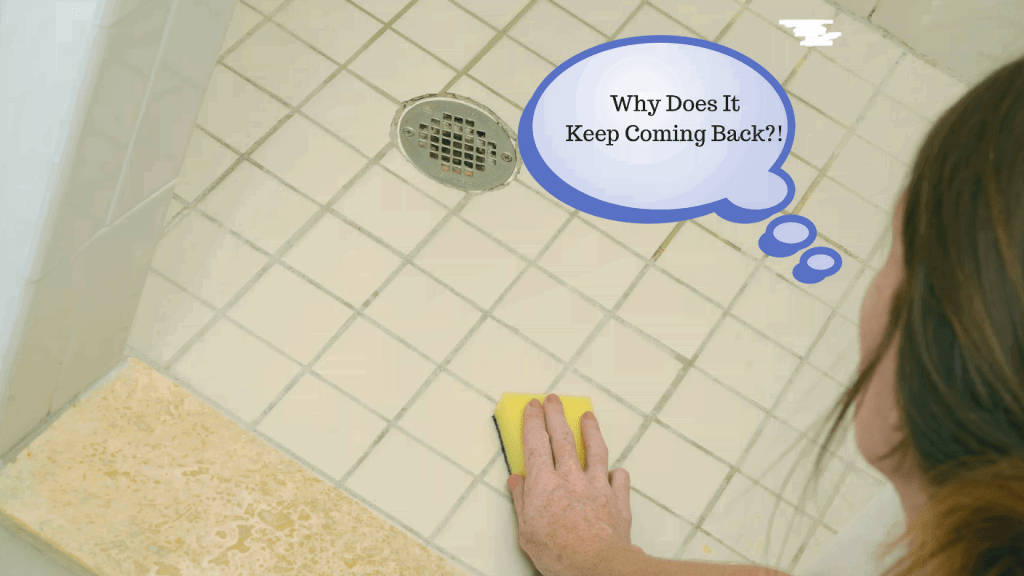
I’m going to describe to you a scenario that is going to sound awfully familiar to you:
You walk into your bathroom only to find a stain of black all around the edges of the shower. The grout in these areas are so black it looks as if there must have been a fire somewhere that left soot in your shower.
But no my friend,
that is mold!
Now you can breathe easy as this type of mold generally won’t get you sick and likely isn’t toxic and grow on your lungs.
However…
You take a shower to get clean, so who the heck wants a dirty shower right?
So as part of your cleaning process you go and some bleach whether it be in the liquid or powder form. You leave it on the grout for about 15-20 minutes and then you go scrub it off.
SUCCESS!
It worked like a charm! You now have a shower which has no mold in it. It’s a happily ever after scenario and it’s the end, right?
Well, two or three months go by and guess what happens?
IT COMES BACK!
The reason why? You guessed it…
The bleach did not kill the mold!
Now you have to go through the same process all over again. It even looks as if the mold formed the same patterns again.
What Should Be Used Instead Of Bleach?
I’m sure you get the point by now of why you shouldn’t be using bleach to clean fungi on the walls (or really anywhere else where mold is present on building material), but if not bleach, what should you use?
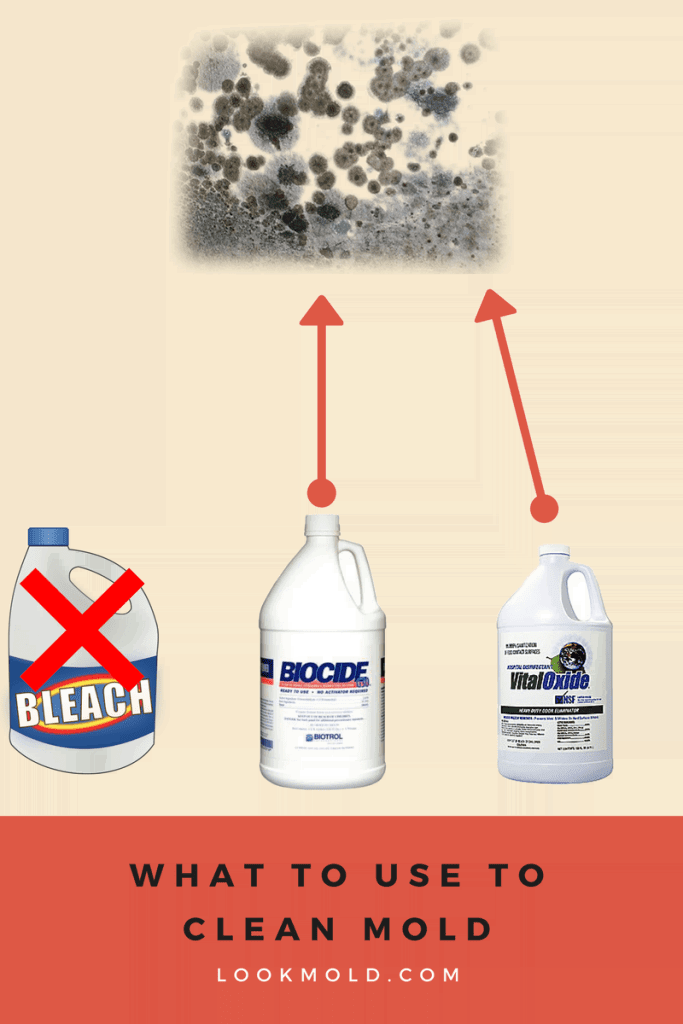
Truth is, there is a good possibility that YOU shouldn’t be using anything to clean mold.
Let me explain:
You see, depending upon what the cause of the mold is and how much of it is present, you should be hiring a mold remediation specialist to complete the work.
Let’s say for example a pipe in your wall breaks while you are in vacation in Paris for two weeks. The whole bedroom is affected and now it looks like this:

This is a situation where the mold present, may be harmful to your health.
Also, if you don’t remove it correctly, it can actually make it worse and can allow airborne mold spores to go through your air conditioning system.
It is recommended that you first have a mold assessment to determine the extent of the mold damage in a situation like this. Have a third party mold assessor instead of calling a mold remediation specialist will give you an unbiased opinion of the mold damage. They are also usually trained and licensed to take samples of the mold so it can be determined what kind of mold is present. Some molds can be toxic, so this is important.
Once it is determined if mold remediation should be performed, the certified mold contractor will actually have to remove some areas most likely.
At that point, the area will then usually be treated with something called either a biocide or fungicide.
The normal person will generally not have access to this.
What If There Is Only A Small Area On Non-Porous Surfaces
If there are is just mold like described in our shower scenario earlier, there are over the counter products you can get like Concrobrium and that may do the trick.
Ultimately, it’s going to come down to what the cause of the mold is. It is not out of the norm for some mold to be present over time in areas that get wet such as sinks, tubs, and toilets.
These situations and nothing to worry about and don’t generally indicate a larger problem. Just remember, it the mold is on porous building materials, especially in a large area, call a professional.
One thing that should be completely clear to you is if you do have mold, bleach-based products should not be used!

Meet the author: Brad Fishbein is an ACAC council-certified Microbial Investigator. In the fall of 2012, he became a Licensed Mold Assessor in the State of Florida through the Department of Business & Professional Regulation. Brad has helped homeowners with over 5,000 successfully completed Mold Inspections since 2009.

